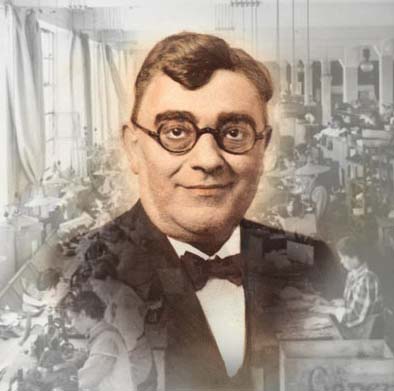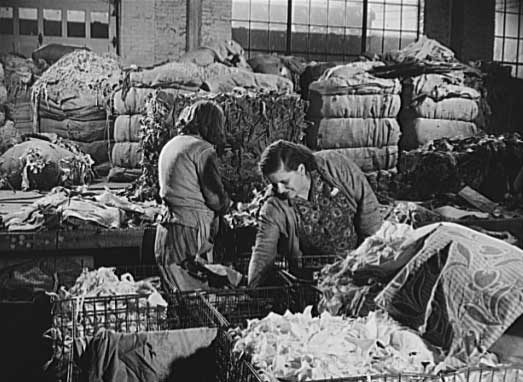SAMUEL GASS,
BusinessMAN
A TRUE TALE OF RAGS TO RICHES
The Rag Business

|
SAMUEL GASS,
BusinessMAN The Rag Business |
|
In Chelsea, Samuel Gass, the greenhorn from Turiysk, found a haven for Jewish immigrants and a place where his Yiddish was readily understood. Although virtually penniless, Samuel possessed a keen business sense. He worked hard, saved his money, and within a few years of arrival he was able to enter the rag business with Isaac Razin, another Russian immigrant living in Chelsea. Isaac's son, Hyman Razin, explained how the partners got started and why they decided to go into the rag business:
"The two men were friends—both had intelligent minds and liked and respected each other. Once Isaac had been in a shop where he observed how hard and well Samuel worked and knew he would make a good business partner. But why the rag business? In the early 1900s, shmattes, [rags] was a big business in Chelsea and a virtual Jewish monopoly. Though neither had much experience in the rag business they chose their vocation because, as Orthodox Jews, they observed the prohibition against working on the Sabbath—Friday sundown to Saturday sundown. Samuel and Isaac knew none of their Jewish competitors would violate the Sabbath. They all shut down at 3:00 on Friday afternoon and didn't reopen until the following Monday morning. Samuel and Isaac could safely shut down their business on Saturday and not lose customers.”[1]
|
|
|
Hyman Razin |
Hyman described the way the rag business worked.
“It began with rag peddlers who rode through the city on horse-drawn wagons yelling, RAGS and buying rags, used clothing, scrap metal and other items that they resold to firms like Gass and Razin. About five or six rag collectors worked the streets of Chelsea. Each had his own route and people knew what day and time to expect them to appear. Samuel and Isaac also purchased rags from larger collectors and junkyards…
|
|
|
Rag collectors in New York City, circa 1896 Credit: Photographer: Elizabeth Alice Austen; Library of Congress, Prints and Photographs Division [reproduction number LC-USZ62-76959 |
"The rags were sorted and graded by quality, color, texture, fiber content, and had to be separated from foreign materials. Sometimes the rags smelled and insects and rodents were a nuisance. After the rags were categorized, they were bailed using a baling press, and held together with burlap and wire. The bales were then sold to dealers, mills, exporters, importers, agents for manufacturers, other middlemen, and the government.
|
|
 |
| Rag workers sorting and grading rags. Shapiro Company, Baltimore, Maryland, 1942 |
Credit: Photographer: Howard Liberman; Library of Congress, Prints and Photographs Division [reproduction number LC-USE6-D-002244 and LC-USE6-D-002245]
|
|
|
|
Rag workers sorting through a bale of cotton waste in order to eliminate pieces of foreign material. Shapiro Company, Baltimore, Maryland, 1942 Credit: Photographer: Howard Liberman; Library of Congress, Prints and Photographs Division [reproduction number LC-USE6-D-002246] |
|
|
|
|
Bales of rags. Shapiro Company, Baltimore, Maryland, 1942 Credit: Photographer: Howard Liberman; Library of Congress, Prints and Photographs Division [reproduction number LC-USE6-D-002243] |
“The price was determined by supply and demand. The Daily Mill Stock Reporter, published in New York, quoted daily prices for rags much like the Wall Street Journal quotes daily stock prices today. Eventually, the rags ended up in the possession of reprocessors and manufacturers who washed and chemically cleaned the rags before reusing their fiber content. Among the many uses for recycled rag fiber were blankets, army and navy goods, clothing, upholstered furniture, and automobile upholstery…
"Under the name of Razin and Gass, the business did well and the partners prospered. Isaac Razin served as the outside man—he was the buyer and seller. Samuel Gass was the inside man—he was a worker and supervisor in the shop…
|
|
|
A panoramic view of the ruins of the great fire that destroyed much of Chelsea, Massachusetts, on April 12, 1908. It is not clear whether the fire destroyed Samuel and Isaac’s rag business or whether they were even in business together at that time. What is known is that Isaac Razin lost all his possessions in the fire. According to his son Hyman, “My father…experienced the Chelsea flood and Chelsea fire in the years 1908 and 1909. He lost everything in both disasters.”[2] Credit: ©1908 Geo. H. Walker & Co. Library of Congress, Prints and Photographs Division [reproduction number: PAN US GEOG-Massachusetts no. 16] |
“Eventually Isaac constructed a modern three-story brick building at the corner of Maple and Summer Streets in Chelsea. He had the expertise to engineer the design and supervise the workers. The building provided approximately 18,000 square feet of interior space. Samuel and Isaac ceased buying from peddlers and brought in rags by the freight-car load from New York, California, and other distant places. They employed five or six workers [mostly Jewish] who could go through a bale of rags (400 to 2000 pounds) a day. Samuel and Isaac stored the rags in their own building and sometimes in a public warehouse when they ran out of room."[3]
Rabbi Baruch Korff, the brother of Samuel's daughter-in-law Adele, gives some insight into how Samuel's business dealings gained him respect in the Jewish community:
"There was a synagogue in Chelsea that was called the Shmatafska Synagogue. Shmatafska because all the rag dealers went there. On the High Holidays, the synagogue would sell portions of the Torah reading. The highest bidders would come up and recite a prayer. It was like an auction. And the others watched Shloime. If Shloime outbid his neighbor, they knew business must be good. It was like a barometer. So, Shloime gradually extended his authority in his home to the synagogue. People, particularly among the immigrants, began to call Shloime ‘Reb Shleime,’ an honorary title." [4]
According to Hyman Razin:
"The rag business was capital intensive and Samuel and Isaac constantly needed funds to buy rags, pay workers, and pay other operating expenses. However, cash flow was impeded because payment on goods sold came 60 to 90 days after the transaction. The business had too many ups and downs, and so in the early 1920s after the economy had soured, Samuel and Isaac mutually agreed to close their business. Both felt terrible but they didn't want to risk losing the tidy sum they had accrued. They made a wise choice. In 1940, the U.S. government passed legislation requiring the labeling of fiber content in manufactured goods and this was the death knell for the rag business. Consumers did want to buy clothing and upholstered furniture manufactured from rags. Demand for virgin materials and synthetic fibers grew and demand for rags virtually disappeared. But although they dissolved their business, the two men maintained their friendship until Samuel Gass's death [in 1954]. They both liked the Turkish bath in Chelsea and would meet there often.” [5]
[1]
Written interview with Hyman M.Razin (Malden, Massachusetts),
by Carole G. Vogel, 8 February 1993. Copy of questions and answers held in
2004 by Paul Gass (Gloucester, Massachusetts).
[2] Letter from Hyman M. Razin
(Malden, Massachusetts) to Paul Gass, 26 June 1990; held by Gass
(Gloucester, Massachusetts, in 2004).
[3] Ibid.
[4] Interview with Rabbi Baruch
Korff (Providence Rhode Island) by Eleanor O’Bryon and Paul Gass, July 1990.
Audiotape and transcript held in 2004 by Paul Gass (Gloucester,
Massachusetts).
[5]
Written interview, Hyman M. Razin, 8 Feb 1993.